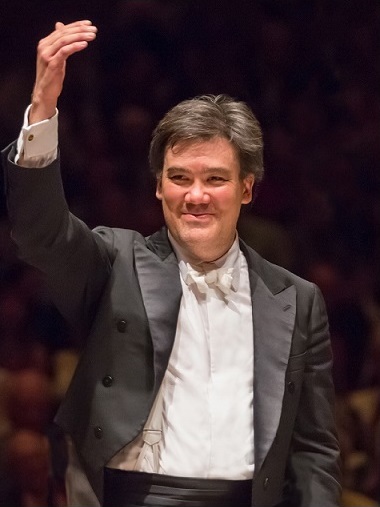Gilbert, Philharmonic at their finest in Mahler, Auerbach premiere

Alan Gilbert conducted the New York Philharmonic Wednesday night at David Geffen Hall.
Alan Gilbert is back in town to lead the New York Philharmonic, with just a few months left in his tenure as music director. Wednesday night at David Geffen Hall, he and the orchestra were at their mutual best in the kind of concert that has been meat and potatoes for the pair for the last eight years: a dynamic world premiere and a superb performance of a classic work.
The new piece came courtesy of the Philharmonic’s commission of composer Lara Auerbach; a violin concerto that featured the talents of this season’s artist in residence, Leonidas Kavakos. The classic was Gustav Mahler’s Symphony No. 4.
Titled NYx: Fractured Dreams, the new piece is the fourth violin concerto from Auerbach. The many-layered title introduced—via Auerbach’s TED-lite talk from the stage—the ideas and some of the qualities of the piece. As Auerbach explained at length (and as she wrote in her program note, and reinforced with an additional poem), she is a night owl and a New York resident, and adapted the Greek goddess of night, Nyx, for expressive purposes. (While Auerbach claimed that Nyx is the goddess of dreams—that role actually belongs to Morpheus, brother of Hypnos, god of sleep.)
Dreams come with sleep, and sleep comes with night, and the New York night is full of external and internal disturbances. Her concerto is organized in thirteen short parts, or “Sognos,” that flow together into a complete whole. Auerbach’s free indulgences in mythology didn’t extended to her composing, which was imaginative, expressive, and tightly organized.
The music maneuvered through many moods, superficially dreamlike, but with a clear sense of order and proportion the feeling was more like that of a mind touring chambers in its own memory palace.
There was a satisfying mix of abstraction and drama, starting with the opening violin solo. Kavakos played a quiet three-note phrase, leading off music that developed in a 19th century manner. With the orchestra joining in with hammering chords, the soloist turned towards evocative sounds, like some glassy sul tasto passages.
NYx was consistently fascinating, evoking complex reactions and drawing the listener on. Auerbach’s colorful scoring—which included an important role for the musical saw—stimulated the ear, and she channeled a broad range of cultural influences that stimulated the mind: Duke Ellington’s jungle sound, the Bernard Herrmann of The Day the Earth Stood Still.
The climax was strong and built powerful dramatic tension, before the finale slowly disappeared like the last wisps of a dream at waking. To recall Hermann again, NYx was like the nocturnal experience of Taxi Driver, but from a more humane perspective.
Kavakos and the orchestra, through Gilbert, played with impressive coordination. There was a small handful of rhythms and phrases that felt less than fully confident. Yet for the most part the playing was full of transparent detail, with precise attacks and balances that let Auerbach’s stained-glass orchestration speak.
After intermission came an expert performance of Mahler’s Fourth Symphony. This made for a rich combination with NYx; the music, as Bruno Walter pointed out, is also dream-like, with the languid atmosphere of sleep and surreal touches like the opening sleigh bells and the witch-like violin dances in the second movement.
Gilbert’s unusual level of animation on the podium seemed to indicate how involved he was in the music making. But nothing was overdone or mannered, the pace was ideal throughout, leisurely and bucolic as per Mahler’s tempo markings, with finely judged modulations and devotion to every marking in the score. The orchestra played phrases all the way through, with attention to each grace note, adjustment in bowing, 16th note rest, or expressive hesitation—all the things that matter in Mahler.
Best of all was the sound. Mahler was the greatest orchestrator, and to play him honestly means capturing his sound. Other of his symphonies have more astonishing effects, but the Fourth has the finest orchestration throughout, every bit of it expressing a sense of strangeness like nothing else in classical music. The Philharmonic’s sound was wonderful, from the four flutes who played with one unified color, to concertmaster Frank Huang’s keening scordatura violin in the second movement.
Soprano Christina Landshamer singing in the final movement was icing on the cake. Her voice has the right youthful quality that the music requires, and her sustained high Gs on each Saint’s verse were pure and luminous.
This program repeats 7:30 p.m. Thursday and 8 p.m. Friday at David Geffen Hall. nyphil.org







Posted Mar 04, 2017 at 12:58 pm by Claus Hirsch
It is a distinct pleasure for a concert goer to read a review like this one by George Grella. He manages to mix a keen historical knowledge of a major work with insightful comments about the orchestra and its conductor. The nontechnical comments also show the human side of his musical appetite. Well done!